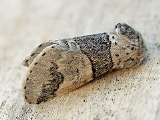
Poplar Kitten
Encyclopedia
The Poplar Kitten is a moth
of the family Notodontidae
. It is distributed throughout Europe
.

This species has white forewings with a broad brown band in the centre and brown dots along the margin. The hindwings are also white with brown dots along the margin. The wingspan
is 44-48 mm. It flies at night from May to July and is attracted to light, the male more so than the female.
The larva
is like a small version of the bizarre-looking larva of the Puss Moth
, with the last pair of proleg
s modified into two long "tails". It feeds on poplar
and aspen
, and occasionally on willow
. The species overwinters as a pupa
in a cocoon on the trunk of its food plant.
Moth
A moth is an insect closely related to the butterfly, both being of the order Lepidoptera. Moths form the majority of this order; there are thought to be 150,000 to 250,000 different species of moth , with thousands of species yet to be described...
of the family Notodontidae
Notodontidae
Notodontidae is a family of moths with approximately 3,500 known species. Moths of this family are found in all parts of the world, but they are most concentrated in tropical areas, especially in the New World...
. It is distributed throughout Europe
Europe
Europe is, by convention, one of the world's seven continents. Comprising the westernmost peninsula of Eurasia, Europe is generally 'divided' from Asia to its east by the watershed divides of the Ural and Caucasus Mountains, the Ural River, the Caspian and Black Seas, and the waterways connecting...
.

This species has white forewings with a broad brown band in the centre and brown dots along the margin. The hindwings are also white with brown dots along the margin. The wingspan
Wingspan
The wingspan of an airplane or a bird, is the distance from one wingtip to the other wingtip. For example, the Boeing 777 has a wingspan of about ; and a Wandering Albatross caught in 1965 had a wingspan of , the official record for a living bird.The term wingspan, more technically extent, is...
is 44-48 mm. It flies at night from May to July and is attracted to light, the male more so than the female.
The larva
Larva
A larva is a distinct juvenile form many animals undergo before metamorphosis into adults. Animals with indirect development such as insects, amphibians, or cnidarians typically have a larval phase of their life cycle...
is like a small version of the bizarre-looking larva of the Puss Moth
Cerura vinula
The Puss Moth is a lepidopteran from the family Notodontidae.The moth can be found in Europe and North Africa. It has a wingspan of 58 to 75 mm. The moth survives the winter as a Pupa in a very solid, wood reinforced cocoon, attached to a tree or pole.The host plants of the moth are the willow and...
, with the last pair of proleg
Proleg
A Proleg is the small fleshy, stub structure found on the ventral surface of the abdomen of most larval forms of insects of the order Lepidoptera, though they can also be found on other larval insects such as sawflies and a few types of flies....
s modified into two long "tails". It feeds on poplar
Poplar
Populus is a genus of 25–35 species of deciduous flowering plants in the family Salicaceae, native to most of the Northern Hemisphere. English names variously applied to different species include poplar , aspen, and cottonwood....
and aspen
Aspen
Populus section Populus, of the Populus genus, includes the aspen trees and the white poplar Populus alba. The five typical aspens are all native to cold regions with cool summers, in the north of the Northern Hemisphere, extending south at high altitudes in the mountains. The White Poplar, by...
, and occasionally on willow
Willow
Willows, sallows, and osiers form the genus Salix, around 400 species of deciduous trees and shrubs, found primarily on moist soils in cold and temperate regions of the Northern Hemisphere...
. The species overwinters as a pupa
Pupa
A pupa is the life stage of some insects undergoing transformation. The pupal stage is found only in holometabolous insects, those that undergo a complete metamorphosis, going through four life stages; embryo, larva, pupa and imago...
in a cocoon on the trunk of its food plant.
- The flight season refers to the British IslesBritish IslesThe British Isles are a group of islands off the northwest coast of continental Europe that include the islands of Great Britain and Ireland and over six thousand smaller isles. There are two sovereign states located on the islands: the United Kingdom of Great Britain and Northern Ireland and...
. This may vary in other parts of the range.

